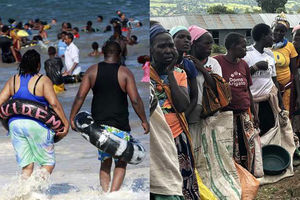Premium
Amapiano: The South African beat that Kenyans cannot stop dancing to

Amapiano singer and dancer Kamo Mphela speaking to journalists during a dance session in Soweto, South Africa on March 21, 2023.
A recent trip to South Africa revealed just how much Amapiano singers are cashing in on the sound whose hit songs have gone viral in recent years.
After a poor reception in 2012, Amapiano re-emerged in 2019 and recorded a major breakthrough that saw the sound become a global export. It is now ranked in the same league as Nigerian Afro-beats, a genre that has clearly punched way above its weight. On Spotify alone, Amapiano has more than two billion streams.
In Kenya, the reception of the genre that originated almost 3,000 kilometres away has been profound. Amapiano-themed events, recreational areas, urban radio stations and countrywide tours have been held in recent months and days.
But it was in 2020 that the sound established itself as a favourite for many young Kenyans.So much so that a number of Kenyan artistes, probably for fear of missing out, jumped on the trend and released localised Amapiano tunes.
Gengetone singer Trio Mio released N’mekapitia, Brandy Maina featured on Movaz Warombosaji Danger Dinji, Afro-pop singer Kagwe Muigai released Chay Chay, Rekles of the Ethic Entertainment featured Brandy Maina on Weka Piano while singer Guardian Angel teamed with his wife Esther Musila to produce Amapiano gospel themed jam Pokea Moyo Wangu, to mention but a few.
But whereas these Kenyans acts didn’t record much success after dubbing the Amapiano beat, the opposite is true for the South Africans who have recorded several performances both in their country and abroad. Music promoter Adias Moyo, who has travelled with some of Amapiano’s biggest acts, revealed that these artistes command hefty fees whenever they perform outside South Africa. They rake in between 50,000 to 200,000 Rand (Sh360,000 to Sh1.4 million).
“An established Amapiano artiste will command a crowd of at least 2,000 revellers outside South Africa, and people pay,” Moyo said.
To corroborate the figures, Sunday Nation spoke to a booking agent who had a hand when Focalistic performed in Kenya in February 2021 at the Summer Fest.
“His performance fees, after taking out the cost of his flight tickets, was $15,000 (Sh1.9 million),” the agent said. The same range applied to DJ Maphorisa and Kabza De Small when the two performed at the Carnivore grounds, in Nairobi in 2021.
“South Africans aren’t as expensive as the other artistes (Nigerians, and international stars). Majority are paid well below $10,000 (Sh1.3 million). I mean, with $5,000 dollars (Sh655,000) you could get Kamo Mphella or Alpha Cut. The only one that I found to be a little pricey was Uncle Waffles who charged $30,000 (Sh3.9 million),” said the agent.
Uncle Waffles, a female Amapiano DJ, also performed in Kenya in 2021, at a time when the sound had penetrated the country and was on wide rotation, thus raising the demand for gigs.
Lesser fees
In South Africa, these stars charge way less for shows. Kamo Mphela’s performance fee is in the region of R35,000 (Sh250,000) and does not include travel, accommodation, flights or transport for her five-member team.
I had a session with DJ Maphorisa at his studio situated in Bryanston, an affluent residential suburb of Sandton, where he created an Amapiano beat from scratch. To book him for a performance, it would cost you R76,000 (Sh548,000).
But away from gig performances, Amapiano artistes are making a kill from music streams with South Africa, Nigeria and Kenya being their key markets on Spotify, which boasts of having the largest Amapiano catalogue on its platform.
Data provided by the Swedish audio streaming platform service shows that globally, Amapiano has attracted over two billion streams since the sound went viral three years ago. This represents a 143 per cent increase year on year.
The genre has garnered a huge following, with more than 240,000 playlists featuring Amapiano in the title and over 10 million playlists featuring at least one Amapiano track.
What’s more, over 40 per cent of Amapiano streams come from listeners outside South Africa, with Kenyans among the top 10 globally.
A curated playlist on the platform dubbed Amapiano Grooves, the biggest Amapiano playlist, has contributed to one billion of these streams.
“Kenyans alone have racked up the seventh-highest number of streams of the Amapiano Grooves playlist. But if we are talking of general consumption of Amapiano music on the Spotify platform, Kenya has the sixth highest number of streams,” Setumo-Thebe Mohlomi, Spotify Music Editor told Saturday Nation.
The Amapiano Groove playlist is the most popular among 18 to 24-year-olds, with listeners hailing from South Africa, the UK, the USA, Mozambique, Botswana, Zimbabwe and Kenya.
“Kenyans have always been great supporters of South African music, even before Amapiano started getting prominence. I could take you back to Brenda Fassie days. She is still a very popular artiste in Kenya many years after her death. Our data shows that. I think whatever happens musically in South Africa will always resonate with Kenyans because their listening palate is already primed to South African music. That’s why jazziest Hugh Masekela is also still popular in Kenya,” Mohlomi said.
Currently, DJ Maphorisa, Focalistic, Kabza De Small, Major League Djz and Kamo Mphela, are among the top exported Amapiano artists on Spotify.
“I wouldn’t lie to you. I have performed in many countries around the world but Kenya is my favourite. I think it really depends on the country you are in. In London and UK it’s about (stage) appearance, in Barcelona (Spain), and Paris (France) they are really not aware of the sound, but when you come to Kenya the audience is always mammoth and goes wild,” Kamo Mphela said during a dance session at her studios in Soweto.





